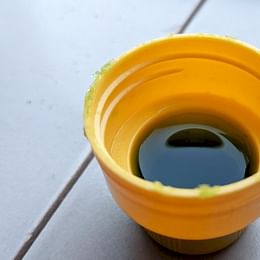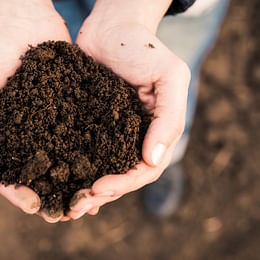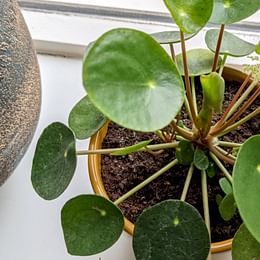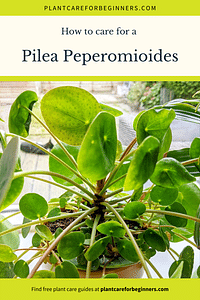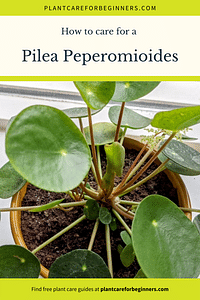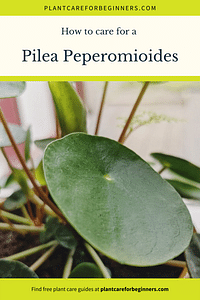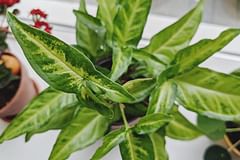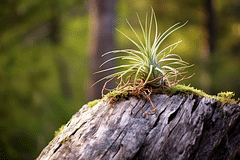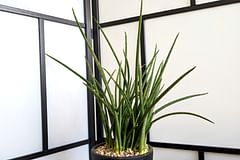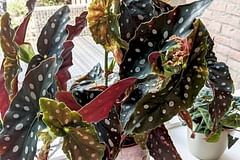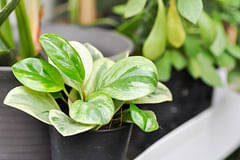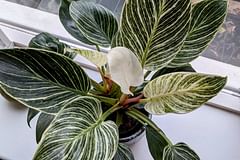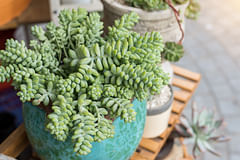How to care for a Pilea Peperomioides
The Pilea Peperomioides or Chinese Money Plant is a fast-growing succulent-like houseplant that is perfect for beginners. It shows you what it needs and when it's not happy. In this plant care guide, we're going to have a look at how to take care of this exciting houseplant.
Last updated on:
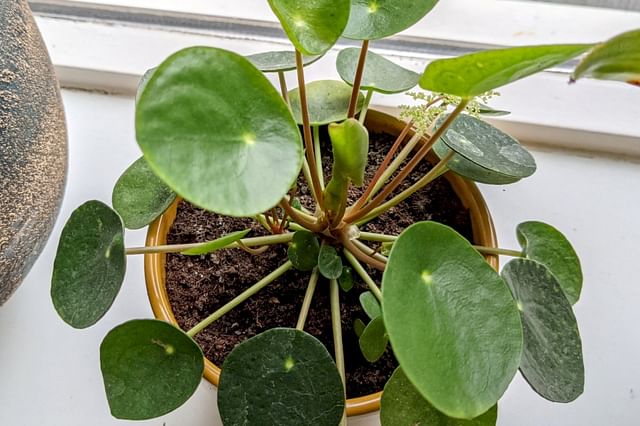 The Pilea Peperomioides, also known as the Chinese Money Plant, is a fast-growing succulent-like houseplant that's great for beginning plant owners. The Pilea might seem like a succulent, with its fleshy leaves, but you shouldn't mistake it for one, as it has very different needs.
The Pilea Peperomioides, also known as the Chinese Money Plant, is a fast-growing succulent-like houseplant that's great for beginning plant owners. The Pilea might seem like a succulent, with its fleshy leaves, but you shouldn't mistake it for one, as it has very different needs.
In this plant care guide for the Pilea Peperomioides, we'll explore what this plant needs to thrive in your home. It's quite an easy plant to take care of, but it does have a few things you should be aware of.
In this guide, we'll look at:
Let's explore how to best take care of your Pilea and help be happy in your house.
Watering your Pilea
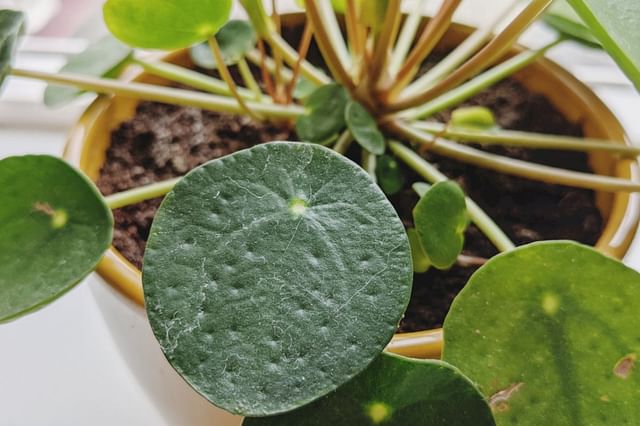
The Pilea is an easy plant when it comes to watering. The Pilea Peperomioides likes to be in moist soil, but should also dry out for 1-2 days. This makes it very easy to water because you can stick to an easy watering schedule: water it once per week. When you water your Pilea once per week, when it's planted in its ideal soil mixture, it will be in moist soil for about 5 days.
When you water your Pilea, it's important to have drainage holes in your pot. These drainage holes make sure that any excess water drains out of the pot. It's important to get rid of any excess water because water that stays behind in the pot could cause root rot. If you don't have any pots with a drainage hole, you can also plant your Pilea in a plastic nursery pot with drainage holes and put that inside of your pot.
Signs your Pilea is being overwatered or underwatered
Pilea peperomioides is a popular houseplant because of its unique leaves. However, like all plants, it is sensitive to overwatering and underwatering, which can lead to a lot of issues.
Signs of overwatering on a Pilea
Signs of overwatering a Pilea Peperomioides include yellowing leaves, soggy soil, and wilting foliage. If the plant has been overwatered, the roots may begin to rot, which can cause the leaves to develop brown spots or fall off entirely. In severe cases, the stem may also become mushy, and the plant may die.
Signs of underwatering on a Pilea
Signs of underwatering include drooping leaves, dry soil, and wilted foliage. If the plant isn't getting enough water, it will struggle to absorb nutrients, which can cause the leaves to turn brown and crispy, especially around the edges. In extreme cases, the plant may go into shock, and the leaves may curl up and die.
To avoid overwatering or underwatering your Pilea Peperomioides, it's important to follow a regular watering schedule based on the plant's needs and environment. Before watering your plant, try sticking your finger into the soil to see the moisture levels. If the soil feels dry, it's time to water. If it still feels damp, wait a few days before checking again.
Curling leaves on your Pilea
If you notice that your Pilea's leaves are curling up, it's thirsty and you should water it. The leaves curl up because they don't contain enough moisture anymore. By watering it, the leaves will fill up with moisture and become flat again.
Drooping leaves on a Pilea
If the top leaves start to droop or become limp, you have overwatered your Pilea. The best thing to do in this situation is to let the soil dry out completely before watering again. It's also important to check if you have the proper pot size for your plant because this can have a huge impact.
Misting your Pilea
The Pilea Peperomioides shouldn't get any water on its leaves, because this will leave water marks. This doesn't harm the plant in any way, but it doesn't look great. This means that you shouldn't spray your Pilea and be careful when watering it, making sure to avoid getting water drops on the leaves.
Light requirements for a Pilea
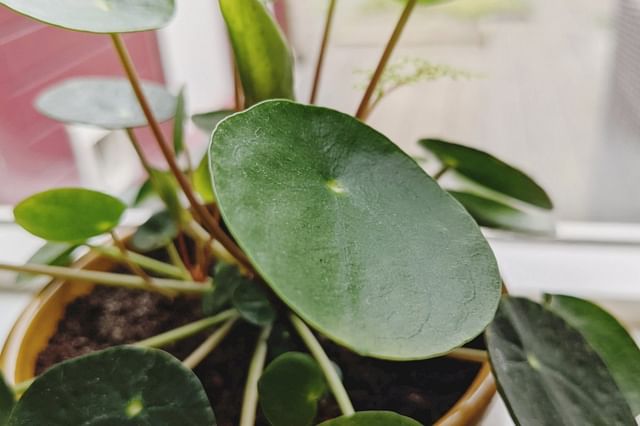
The Pilea Peperomioides is an amazing plant for those places that get bright indirect sunlight. It needs sunlight to grow properly and doesn't do well in low-light places. It's also important to not expose the Pilea to bright direct sunlight.
When you expose your Pilea to direct sunlight, it will get sunburns. These sunburns look like small yellow spots on the leaves. If they're very small spots and your Pilea hasn't been in direct sunlight for too long, they might heal over time.
When you put your Pilea in a place where it's not getting enough sunlight, your Pilea will tell you. Like succulents, a Pilea will become leggy and grow towards the light, just to get enough of it. When you see this happen, make sure to move it to a brighter spot. Unfortunately, your Pilea won't turn back to its non-leggy shape, but you can propagate it to try again with a new plant.
The ideal temperature and humidity for your Pilea
If you're a proud owner of a Pilea Peperomioides, you might be wondering what temperature and humidity levels are ideal for this trendy houseplant.
Temperature
The Pilea Peperomioides is a great indoor plant because it can survive in a range of temperatures. However, to ensure optimal growth and health, aim for a temperature between 15-24 degrees Celsius (60-75 F).
Avoid placing your Pilea Peperomioides near drafty windows, air conditioning units, or heating vents that can cause extreme temperature changes and stress the plant. Keep in mind that during the winter months, plants may need extra warmth and humidity to thrive.
Remember to monitor your plant and adjust accordingly if you notice any signs of stress such as yellowing leaves or stunted growth.
Humidity
Not only is the Pilea Peperomioides well adapted to the temperatures of most homes, it also likes the average humidity levels in most homes. The ideal range for your Pilea falls between 40% to 60% humidity, which most houses naturally have. So you likely won't have to change a thing.
If the air is too dry, your pilea may develop brown, crisp edges on its leaves, while excess humidity can lead to fungal diseases and rot. To keep your plant happy and healthy, it's recommended to invest in a hygrometer, which can measure humidity levels in your home.
If you find that your air is too dry, there are a few easy ways to increase humidity. You can place a tray of water near the plant, allowing the water to evaporate and raise humidity levels.
The best soil for a Pilea
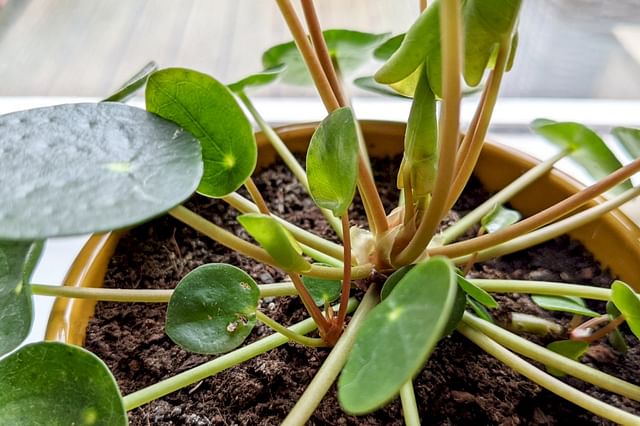
The best soil for a Pilea is soil that can retain moisture for a few days and drain excess water quickly. This type of soil often contains coconut coir and Perlite. Coconut Coir and Perlite help the soil to retain moisture for longer but also make sure that any excess water drains to the bottom of the pot.
If the excess water were to stay in the soil, around your plant, it could overwater your plant. Coconut Coir and Perlite also help to give your soil a good structure to prevent the soil from compacting over time.
When the soil compacts and/or never dries out, oxygen doesn't get a chance to reach your plant's roots. If this happens often, this will cause root rot and could kill your plant. It's also important that the soil dries out for a day or two before you water your Pilea again. When the soil is dry it's much easier for oxygen to reach your Pilea's roots.
This type of soil isn't hard to find. You can buy this soil pre-mixed or mix it yourself. If you want to mix it yourself, you can find some more help in this guide: How to make your soil retain more water?. If you prefer to buy pre-mixed soil, you can use the same soil as you would for a Palm.
Fertilizing your Pilea
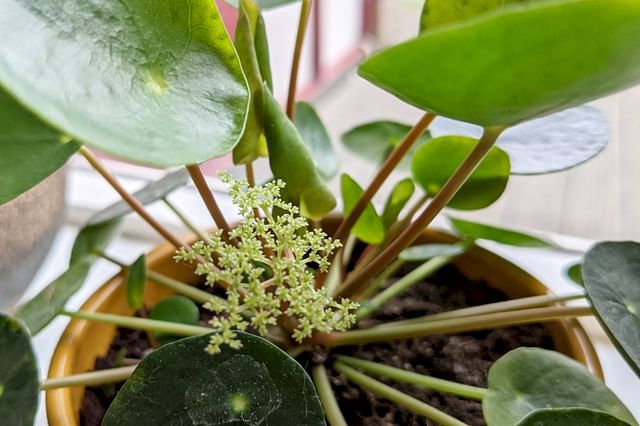
In the introduction we've seen that the Pilea is a fast-growing houseplant. Like most other fast-growing plants, the Pilea needs a lot of energy to grow. You can help to give it this much-needed energy by fertilizing it.
Fertilizing your Pilea is straightforward: fertilize it once per month in the spring and summer. In the fall and winter, don't fertilize your Pilea, as it will be dormant and needs to rest. The best fertilizer to use is liquid fertilizer, as your Pilea will absorb this more quickly and it can use this new energy to grow.
If you keep fertilizing your Pilea in the fall and winter, it won't be able to absorb all nutrients. Any leftover nutrients stay behind in the soil and make it salty over time. This is a bad place for the plant to grow because it will make your Pilea dehydrated and make it so the roots have trouble absorbing any moisture. This can kill your plant if you let it go on for too long.
You can correct this by watering your Pilea generously and washing the leftover fertilizer away by letting it drain from the drainage holes in the pot.
How long does it take to grow new leaves on a Pilea
Pileas are fast-growing houseplants. It can produce new leaves year-round as long as it is given proper care. On average, a Pilea Peperomioides plant can grow up to 12 inches in height and 12 inches in width within a year.
The growth rate of new leaves largely depends on the amount of light, water, and nutrients the plant receives. In ideal conditions, new leaves can grow and unfold within a matter of weeks, and the plant can produce several new leaves within a few months. However, growth will slow down during the winter months when the plant goes into its dormant phase.
To encourage healthy leaf growth, you should keep the plant in bright, indirect light and water it regularly, making sure not to overwater. Fertilizing the plant every few months can also promote healthy leaf growth.
Propagating your Pilea
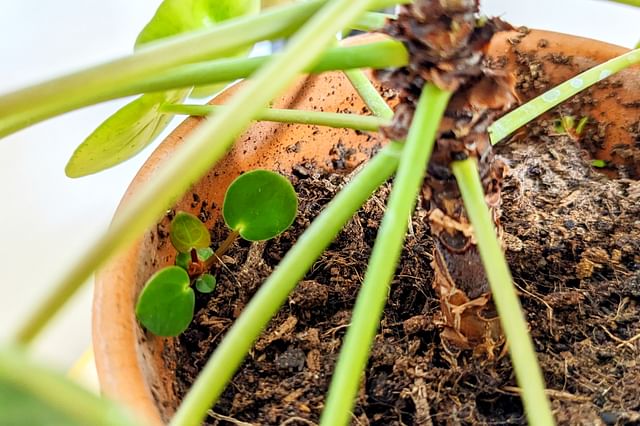
Pilea Peperomioides plants are incredibly easy to propagate, and there are a few different ways you can do it. Here are a few options:
-
Propagation by stem cuttings: This is the most common method of propagating Pilea Peperomioides. Simply cut a healthy stem, making sure it has a few leaves attached, and place it in a jar of water or directly into the soil. Keep the soil moist, but not too wet, and within a few weeks, you should see new growth.
-
Propagation by division: If your Pilea Peperomioides has multiple stems or offshoots, you can gently separate them and plant them individually in a pot. Make sure each new plant has some roots attached, and keep the soil moist until they begin to establish themselves.
-
Propagation by seeds: This is a less common method, as it's more difficult and time-consuming. Pilea Peperomioides plants produce tiny, black seeds that can be difficult to collect. If you do manage to collect some, you can plant them in soil and keep them moist until they germinate.
Overall, Pilea Peperomioides plants are very tough and forgiving, so don't give up if your first propagation attempt isn't successful. Keep trying, and with a little patience and care, you'll soon have a whole collection of these plants! And I mean that! These plants really do grow quickly as if they're weeds. So you'll soon have a few to give away as well. Share the plant love!
Pruning a Pilea
If you're wondering whether you should prune or trim your Pilea Peperomioides, the answer is yes! Pruning your Pilea can help promote fuller growth and prevent legginess. It can also help prevent overcrowding and remove any damaged or diseased foliage.
To begin, check your Pilea and determine which areas need pruning. Look for any stems that are overgrown, leggy, or damaged. Then, using a sharp, clean pair of scissors or pruning shears, make a clean, angled cut just above a node or leaf. This will help encourage new growth.
When trimming your Pilea, focus on removing any yellow or brown leaves. These are likely dead or dying and can take energy away from the plant. Use your scissors or pruning shears to make a clean cut right at the base of the leaf stem.
Remember, it's important to take care when pruning or trimming your Pilea Peperomioides. Make sure your tools are clean and sharp to prevent damaging the plant.
The ideal pot size for a Pilea
For a lot of plants, the size of the pot isn't that important, but it is for the Pilea. If you notice that your Pilea isn't growing (quickly), it might be in a pot that's either too small or too large.
If your pot is too small, your Pilea won't have any space to grow, so it won't grow. If your pot is too large, it's quite easy to overwater your plant. It's easy to overwater your plant because the Pilea might not have roots all over the pot yet so the soil will likely never dry out. As we've already discovered, your soil needs to dry out to prevent root rot.
The ideal pot size is this: slightly larger than the roots. This slightly larger pot size gives the plant plenty of space to grow. This size pot also helps to avoid overwatering your plant.
Repotting your Pilea
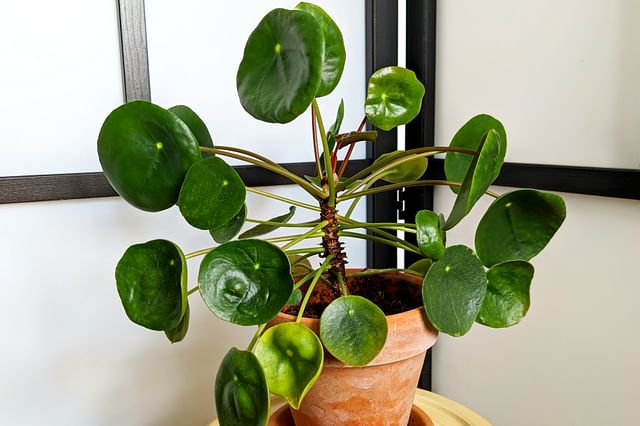
If you're a proud owner of a Pilea Peperomioides, you might be wondering when it's the right time to repot your beloved plant. Repotting is an essential part of plant care, as it makes sure that your plant is getting the space and nutrients it needs to thrive.
You should repot your Pilea once every one to two years. This timeframe might be different for your plant. Your plant might need space more quickly or less often. The size of the pot also makes a difference. If you have a small pot, you'll have to repot more often. If the pot is already quite large, you won't have to repot as often.
A good sign that it's time to repot your plant is when you notice that the roots are starting to outgrow the pot. In this case, you can choose to move your plant to a slightly bigger pot to give it room to continue growing. It's important to use a pot with drainage holes to prevent water from accumulating, which can lead to root rot.
Another sign that it's time to repot your Pilea is if you are starting to see yellowing or wilting leaves, which can be a sign of nutrient deficiency. By repotting your plant, you can make sure that it's getting all the nutrients it needs to stay healthy and vibrant.
Don't be afraid to get your hands dirty and repot your plant! It's a great opportunity to examine your plant's roots and refresh the soil.
Can I place my Pilea outside in the summer?
Pilea plants can thrive when placed outside during the summer months. This plant naturally grows in the shaded ground of the forest making it adaptable to lower light levels. However, during the summer, it can handle a bit more (indirect) sunlight, so placing it on your patio or balcony would be perfect.
When placing your Pilea outside, make sure it is not exposed to extreme temperatures, especially the hot afternoon sun. If you live in a particularly hot or dry climate, be sure to provide some shade during the hottest parts of the day. Maintain regular watering schedules, but be sure the soil drains well to prevent root rot.
If you live in a hot climate, you might need to water your plant a little more often, so check the soil often to find out how quickly it dries out.
Preventing your Pilea from becoming leggy
If you want to prevent your Pilea Peperomioides from getting leggy, there are several steps you can take to keep it compact and bushy!
First of all, make sure that your plant is getting enough bright indirect sunlight. So, find a spot for your Pilea that is bright but shaded, such as near a window with thin curtains.
The second step to prevent leggy growth is to adjust your watering habits. Overwatering can cause the plant to grow weak and spindly, so make sure the soil is well-drained and allow the top inch or so of soil to dry out before watering again.
Also, it's best to avoid fertilizing your Pilea during the winter months when growth slows down - too much fertilizer can encourage rapid, leggy growth.
If you notice that your Pilea is starting to get leggy, don't worry! You can still take steps to promote bushy growth. One way is to pinch off the tips of the stems. This will encourage the plant to branch out and grow more leaves. You can also try pruning back any leggy stems to a more compact size.
How to prevent and treat pests on a Pilea
Even though Pilea plants are beginner-friendly plants that are easy to take care of, it still has to deal with pests from time to time, especially spider mites. These tiny pests can cause major damage to your Pilea, with spider-like webs and holes in the leaves. Luckily, there are several ways to prevent and control spider mites on your Pilea Peperomioides.
Keeping your Pilea in a healthy environment is crucial. Spider mites prefer dry and dusty conditions, so make sure to keep the humidity level at around 40-50%. Also, make sure that your Pilea has enough airflow and is not overcrowded with other plants.
You can also prevent spider mites by regularly wiping down the leaves with a damp cloth or sponge. This will not only remove any dust and debris but will also help to prevent spider mites from establishing their webs on the leaves.
Another effective method is to use neem oil. Neem oil is a natural plant-based pesticide that is both safe and effective in controlling spider mites. Mix a few drops of neem oil with water, and carefully wipe the leaves off with it. This will not only control spider mites but will also prevent other pests from infesting your Pilea.
Conclusion
The Pilea Peperomioides or Chinese Money Plant is a great houseplant for beginning plant owners because it shows you what it needs. When you water it too much, it will become droopy and limp. When you water your Pilea too little, its leaves will curl up to show you it's thirsty.
Your Pilea will even tell you if it's not happy with the amount of sunlight it's getting. When it's getting too much sunlight, yellow spots will show up on its leaves. When it's getting too little sunlight, your Pilea will become leggy and stretch out to grow toward the light.
This beginner-friendly houseplant shows you what it needs, but it's also a very fast-growing plant. This is great for beginning plant owners because you get a lot of exciting growth quickly. Can you think of a better way to start your plant journey?
Thank you for reading this post! I hope it helps you to keep your plants healthy and beautiful! If you're looking for more guides on specific plants, you can always request a plant guide to get a guide for the plant you have trouble with.
Tags: beginner-friendly, Plant care tips, fast-growing
Posted on: May 8, 2021 Last updated on: Jul 20, 2023